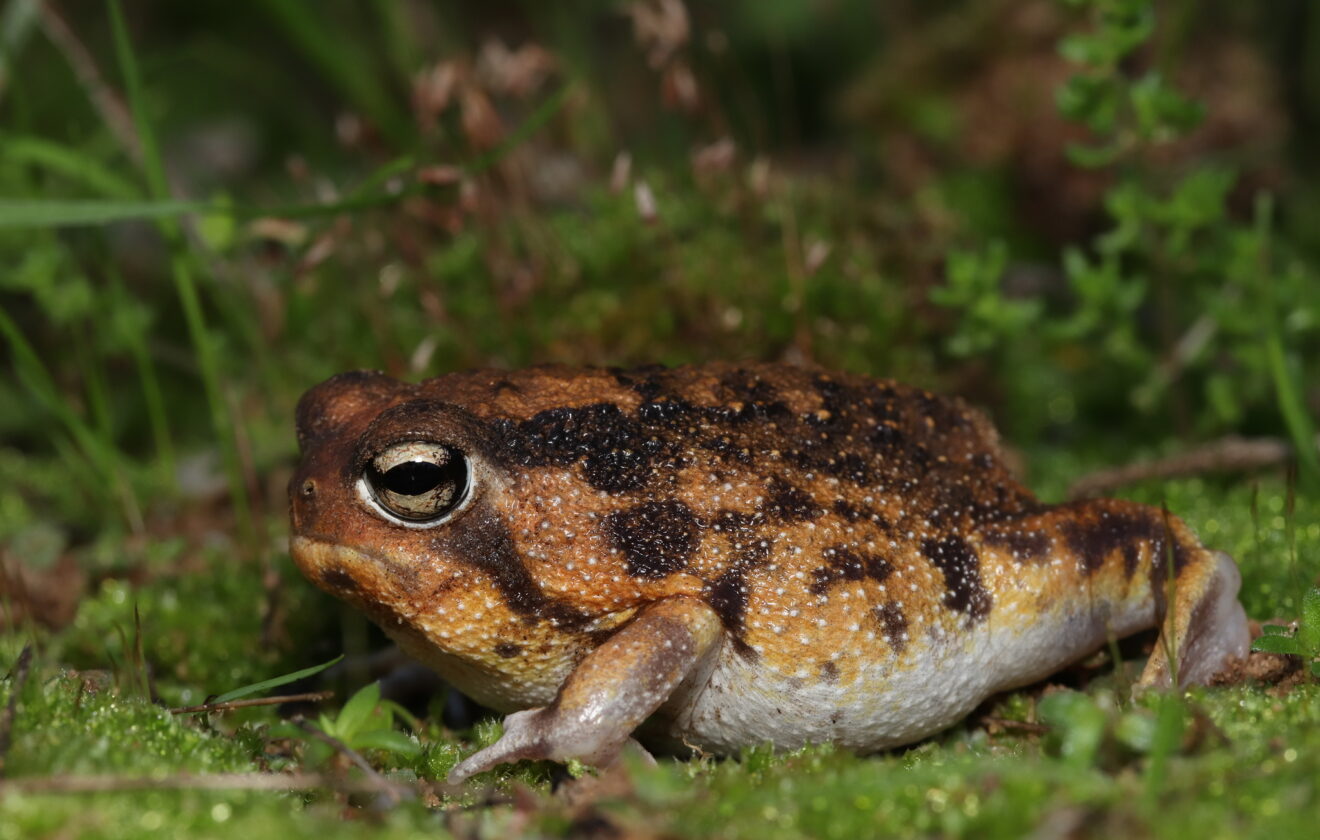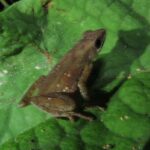- Introduction: Meet the Namaqua Rain Frog
- Taxonomy and Classification
- Geographic Range and Natural Habitat
- Physical Characteristics and Unique Adaptations
- Behavior and Life Cycle
- Ecological Significance in the Karoo
- Threats and Conservation Status
- Cultural and Scientific Significance
- Conclusion: Appreciating an Unsung Desert Frog
Introduction: Meet the Namaqua Rain Frog#
In the shifting sands and arid landscapes of coastal southern Africa, an unassuming amphibian captivates nature enthusiasts with its peculiar appearance, endearing squeaks, and fascinating underground existence. Meet the Namaqua rain frog, scientifically known as Breviceps namaquensis, a tiny amphibian whose unusual shape, expressive face, and distinctive behavior have earned it global admiration.
While frogs often conjure images of lush tropical forests or serene wetland pools, the Namaqua rain frog subverts expectations entirely. Remarkably adapted to life in one of the most inhospitable habitats, this species exemplifies nature’s ingenuity, equipped to thrive where few other amphibians can endure. Known affectionately as “desert potato frogs” due to their round body and plump stature, these amphibians prove that nature’s treasures come in the most surprising packages.
Taxonomy and Classification#
The Namaqua rain frog belongs to the family Brevicipitidae, a small family distinguished by short limbs, rounded bodies, and remarkable subterranean lifestyles. Scientifically classified as Breviceps namaquensis, this species was first described by the French zoologist André Marie Constant Duméril and his assistant Gabriel Bibron in 1841.
The genus Breviceps encompasses approximately 20 known species collectively known as rain frogs. The Namaqua rain frog maintains a close evolutionary relationship with species such as the Desert rain frog (Breviceps macrops), sharing similar ecologies, appearances, and behavioral patterns. Despite these close kinships, subtle distinctions in skin texture, coloration, and vocalization help scientists confidently differentiate between them in the field.
Geographic Range and Natural Habitat#
The Namaqua rain frog occupies a narrow but intriguing strip along the western coastline of South Africa and southern reaches of Namibia. Primarily found within the Succulent Karoo biome—a biodiversity hotspot notable for its remarkable plant diversity and ecological uniqueness—these hardy amphibians have adapted to incredibly harsh conditions characterized by low rainfall, high temperatures, and sandy terrains.
A Life Buried Beneath the Sands#
Unlike most frogs that rely heavily on open water bodies, Namaqua rain frogs are meticulously adapted to a life predominantly beneath the surface of sandy dunes and coastal flats. They seek shelter below the surface during the scorching daylight hours and emerge under the cover of dusk or following rare bouts of rainfall to forage or engage in reproductive activities. Their habitat choice provides shelter from harsh climatic conditions, reduces predation exposure, and plays a fundamental role in their fascinating behavioral adaptations.
Physical Characteristics and Unique Adaptations#
At first glance, the Namaqua rain frog appears delightfully comedic—more reminiscent of some animated character than a typical wild amphibian. Adults typically measure a diminutive 4–6 centimeters, boasting a rounded, flattened body shape with exceptionally short limbs and no visible neck region. Their rotund form, coupled with protruding eyes and characteristically downturned mouths, creates a perpetually disgruntled yet endearing facial expression.
The coloration includes subtle yet effective camouflage patterns that range from sandy beige and pale yellowish-brown hues to darker patches, offering effective concealment amongst sandy soils. Their skin is rough, relatively thick, reducing moisture evaporation crucial to combat desert aridity. Unlike most frogs, their hind limbs are remarkably short, incapable of effective leaps—yet perfectly suited to burrowing rapidly into loose sand when threatened.
Survival by Camouflage and Concealment#
Their round, sand-colored bodies seamlessly blend into their desert surroundings, an evolutionary mastery that provides protection from keen predators such as birds, small mammals, and reptiles. Coupled with powerful yet short limbs capable of rapid excavation, Namaqua rain frogs can vanish beneath the sand in mere moments—leaving predators bewildered and empty-handed.
Behavior and Life Cycle#
Distinctive Vocal Communication#
One of the most famous aspects of the Namaqua rain frog’s behavior is its unique call—a surprisingly high-pitched, squeaky sound that defies expectations from a creature of such modest proportions. Males emit these plaintive calls primarily to attract females during the breeding season, offering a chorus of “squeaks” resonating through moonlit Karoo evenings.
Courtship and Unusual Breeding Habits#
Breeding coincides closely with the sparse rainfall events scheduled unpredictably by the Karoo’s arid climate cycles. After rainfall, males surface to vocalize aggressively, fighting for females’ attention and access to prime breeding territories, often underground chambers prepared carefully beforehand. Surprisingly, fertilization occurs underground within damp chambers constructed meticulously by the female and assisted by the male.
Eggs are carefully and protectively laid beneath the surface—not presented openly in freshwater pools as in typical frogs. Females guard these subterranean nests, illustrating a rare and valuable instance of parental investment found within amphibian populations. The Namaqua rain frog doesn’t have a traditional aquatic tadpole stage; instead, juveniles develop directly within eggs, emerging into miniature adults ready for life underground.
Ecological Significance in the Karoo#
Despite their small stature and seemingly secretive lifestyle, Namaqua rain frogs fulfill vital ecological roles within their harsh desert ecosystem. Serving as voracious consumers of invertebrates—primarily ants, termites, and small beetles—they effectively contribute to controlling insect populations, playing a subtle yet essential part in ecosystem balance.
Simultaneously, they are valuable prey for numerous predators. Their existence supports broader trophic dynamics, emphasizing the interconnectedness of biodiversity within environments often thought of as barren. Additionally, their sensitivity to changing environmental conditions positions Namaqua rain frogs as potential biological indicators, alerting conservationists and researchers to broader environmental threats and ecosystem alterations.
Threats and Conservation Status#
Currently, the Namaqua rain frog holds an IUCN Red List status of Least Concern, indicating stable populations across much of its range. However, complacency must be avoided, as development pressures, habitat degradation, invasive plant species proliferation, and climatic fluctuations driven by global climate change could threaten their delicate terrestrial habitats in future years.
Habitat Loss and Human Encroachment#
Increased coastal development, mining, agriculture expansion, road construction, and tourism activities present genuine threats. These human-driven endeavors significantly disrupt critical coastal and Karoo sand habitats essential for their reproduction, feeding, and subterranean shelter.
Climate Change and shifting rainfall patterns#
The Namaqua rain frog depends heavily on the predictability and reliability of sporadic rainfall events. Climate models forecast shifting weather patterns, including prolonged droughts and altered precipitation schedules—factors extraordinarily challenging for reproduction and survival if rain frogs can’t adapt swiftly enough.
Cultural and Scientific Significance#
Besides their ecological value, the Namaqua rain frog has become something of an internet celebrity. Popular viral videos of their amusing calls, plump appearance, and endearing facial expressions frequently generate worldwide attention, raising awareness about otherwise overlooked amphibians and their ecosystems.
Their appealing characteristics help foster conservation dialogue among diverse audiences, encouraging global amphibian conservation awareness. Moreover, ongoing studies of their unique adaptations and physiological resilience provide scientists valuable data that can inform broader conservation strategies, climate resilience, and inspire biomimicry innovations.
Conclusion: Appreciating an Unsung Desert Frog#
The Namaqua rain frog, with its quirky personality and astonishing adaptations, invites deeper reflection on the astounding diversity of life—and its urgent conservation needs—in southern Africa’s unique arid ecosystems. These frogs, small yet resilient survivors, carry an important global conservation message: even the tiniest, unassuming creatures can teach profound lessons about nature’s resilience, ingenuity, and beauty.
By deepening our understanding and appreciation of this remarkable amphibian, we reinforce a broader commitment to preserving biodiversity, safeguarding ecosystems, and critical habitats worldwide. Each of us can partake—whether through awareness, education, or support of conservation, we collectively ensure that species like the Namaqua rain frog continue thriving alongside us, enriching our shared planet.















